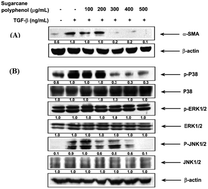Anti-fibrotic activity of polyphenol-enriched sugarcane extract in rats via inhibition of p38 and JNK phosphorylation†
Abstract
Sugarcane (Saccharum officinarum L.), which is one of the most important sources of sugar, is also rich in polyphenolic compounds. In this study, polyphenols from sugarcane were extracted, and the dominant component was characterized quantitatively via HPLC to be (−)-epicatechin. Fibrosis occurs in many organs and is associated with severe tissue damage. Liver fibrosis is the excessive accumulation of extracellular matrix proteins and advanced liver fibrosis, resulting in cirrhosis, liver failure and portal hypertension. Thus, the prevention and treatment of liver fibrosis is urgent. Therefore, we further investigated the protective effect of sugarcane polyphenol extract (SPE) on carbon tetrachloride-induced liver fibrosis in rats and observed that SPE (20 or 50 mg kg−1) improved the serum GOT (glutamic oxaloacetic transferase) and GPT (glutamic pyruvate transaminase) levels and decreased the expression of α-smooth muscle actin (α-SMA) in liver tissues. The mechanistic study showed that in transforming growth factor β1(TGF-β1)-induced hepatic stellate cells (HSCs), SPE attenuated the phosphorylation of p38 and JNK1/2 and down-regulated the expression of α-SMA. Collectively, SPE mitigated carbon tetrachloride-induced liver fibrosis in rats and its mechanism may be related to the p38 and JNK signalling pathways.



 Please wait while we load your content...
Please wait while we load your content...